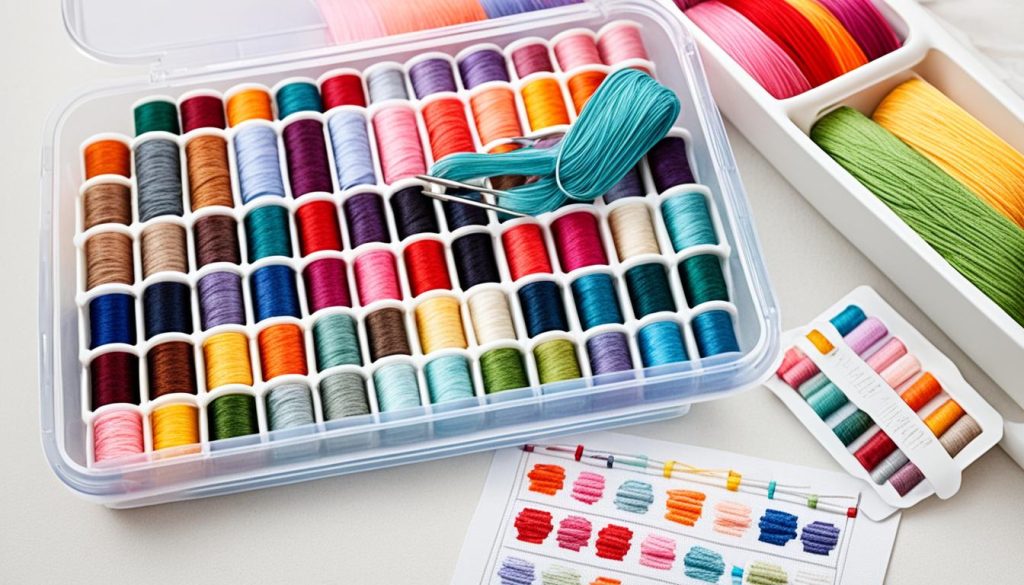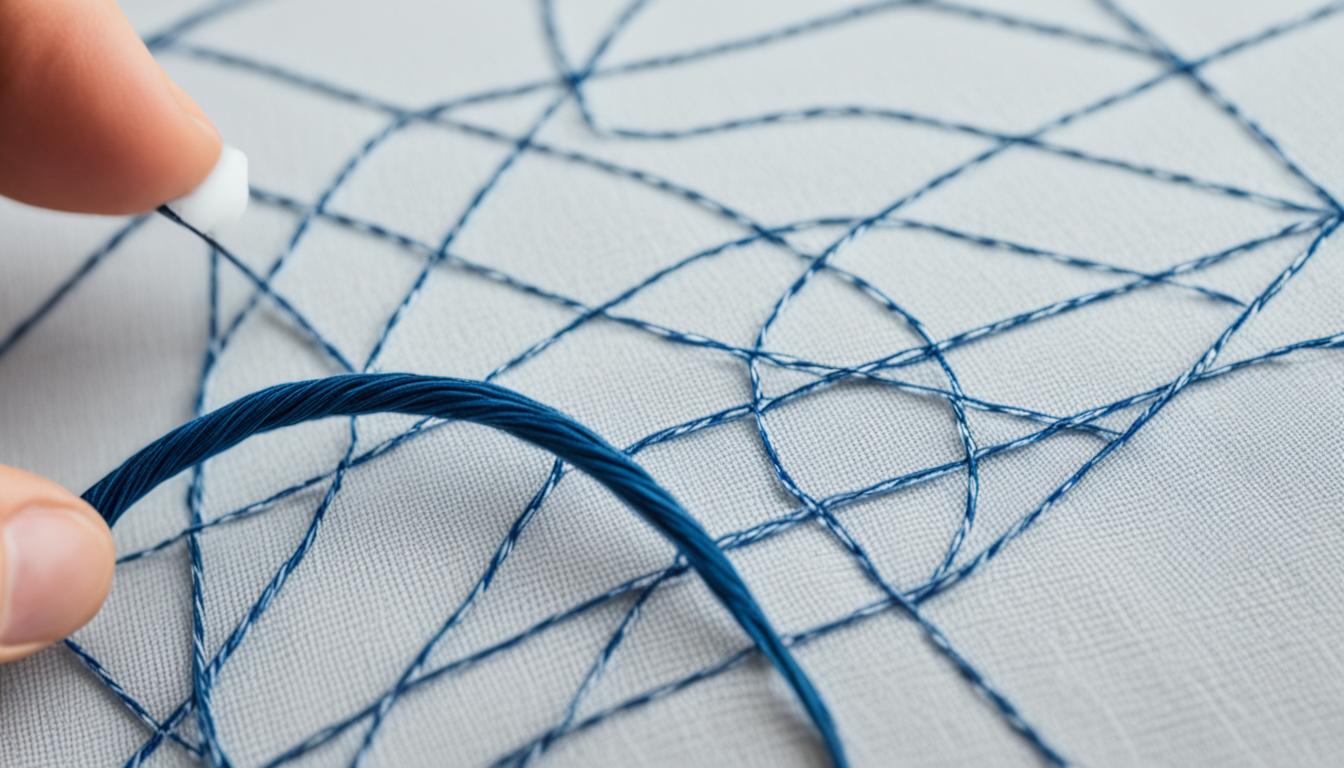Cross stitch is a popular and easy type of embroidery. It’s great for new learners. You use a special fabric and X-shaped stitches to make designs. These designs can be anything from old-style to modern, giving you lots of freedom. You can start with a kit or make your own design.
This craft is not just fun, it’s also relaxing. It helps you make your home pretty or create special gifts. So, enjoy making something unique with your hands in crossstitching.
Key Takeaways
- Average length of floss used per stitch is 18 inches.
- Common fabrics include Aida and linen, with Aida being ideal for beginners.
- Typically, one or two strands of floss are used for stitching.
- For securing thread, pass under at least three stitches.
- Free shipping on U.S. orders over $75.
- 6 issues of The World of Cross Stitching magazine can be purchased for £9.99.
- It is recommended to start on 14-count Aida fabric using two strands of cotton.
Understanding Cross Stitch Basics
Cross stitch is a traditional craft. It uses X-shaped stitches to create patterns. People of all skill levels can make beautiful works with it. You use special fabrics like Aida or linen for this craft.
What is Cross Stitch?
This type of stitching is found on fabric with even holes. This makes it great for detailed work. We usually use two strands of DMC floss for each stitch. This gives your piece a nice, consistent look.
Patterns are often shown on grids. These grids help you to stitch accurately. Each square on the grid stands for a single stitch.
Why Choose Cross Stitch?
Cross stitch is known for being both relaxing and fun. It’s easy to learn and very flexible. You can choose from traditional to modern designs. This craft really fits any style.
Getting started is simple. You can find fabrics and needles easily. Kits come with all you need, like threads and patterns. This makes beginning a project easy.
Benefits of Cross Stitch
Cross stitch offers many perks:
- It’s simple to follow patterns, reducing the stress for beginners.
- You can create detailed designs no matter your skill level.
- The act of stitching can be very calming and helps with stress.
- It starts easy and gets more challenging, keeping you engaged.
- Finishing a stitched piece is very satisfying. It makes great gifts or home decor.
Cross stitch is not just fun; it’s also very rewarding. Anyone can enjoy it, no matter their skill.
The Essential Cross Stitch Supplies You’ll Need
A good cross-stitch project starts with the right materials. You need to pick the top crossstitching fabric, crossstitching needles, crossstitching threads, crossstitching hoops, and crossstitching frames. This makes crafting much easier and fun.

Fabric: Aida vs. Linen
The type of crossstitching fabric you choose really matters. If you’re just starting, go for Aida fabric. Try the 14-count Aida because it has easy-to-see holes. This makes stitching easier. For those more experienced, linen is great. It has a unique weave but it’s harder to work with. Rewards come from the effort.
Choosing the Right Needles
Getting the right crossstitching needles is very important. For beginners, tapestry needles size 24 are a good choice. They have blunt ends that are easy to use. They also don’t harm the crossstitching fabric. These needles have big eyes, which means crossstitching threads can be threaded easily.
Floss and Threads
Cross stitch threads usually means six-stranded embroidery floss. Look for brands like DMC and Anchor. They have strong, lasting colors for any project. DMC particularly stands out for its Egyptian cotton threads. Make sure to separate and thread your floss correctly for the best results in your patterns.
Using Hoops and Frames
Cross stitch hoops and frames can make stitching smoother. Beginner-friendly wooden hoops keep the fabric taut and flat. They are available in different sizes to fit your project. It’s also key to prepare your cross stitch fabric by binding the edges. This prevents fraying and helps your stitching to be neat.
| Supply | Recommended For | Brands |
|---|---|---|
| Cross Stitch Fabric | Beginners | Aida (14-count), Linen |
| Cross Stitch Needles | Beginners | Tapestry Needles Size 24 |
| Cross Stitch Threads | All Levels | DMC, Anchor |
| Cross Stitch Hoops | Beginners | Wooden Hoops (4″ to 18″) |
| Cross Stitch Frames | Advanced | Various |
How to Start Your First Cross Stitch Project
Starting your first crossstitching project is exciting. There are several steps to follow. Let’s go through them together.
Begin by picking your materials. Often, kits are available with all you need. Choose a pattern that you like. Be sure it’s simple to start. Then, prepare your fabric. To find the middle, fold your Aida or linen twice. It’s key for the pattern to be right.

After your fabric is set, put it in a frame or hoop. This keeps it tight for easier stitching. Make sure your floss is set. Cut and separate it according to your pattern’s needs.
When it’s time to stitch, check your chart. Follow the colors and symbols to know which floss to use. Begin in the pattern’s center and move outward. Stitch neatly without long gaps.
Getting the thread right is crucial. Before your first stitch, weave the thread at the back. Do the same at the end. This helps keep the back of your work neat without knots.
Remember to let the thread unwind as you go. This can prevent tangles. As you stitch more, your skill will improve. This first project prepares you for harder designs. Have fun with it!
| Step | Action | Tips |
|---|---|---|
| 1 | Select materials | Choose a simple, appealing pattern |
| 2 | Prepare fabric | Find the center for proper alignment |
| 3 | Use a hoop | Maintain even tension |
| 4 | Separate floss strands | Use one to two strands as required |
| 5 | Read the chart | Match colors and symbols to floss |
| 6 | Start stitching | Begin from the center and work outwards |
| 7 | Secure the thread | Weave at the back without knots |
| 8 | Untwist thread | Let it hang freely to unwind |
Tips and Tricks for Perfect Stitches
Cross stitching is a fun and creative craft. It’s all about knowing what to do and practice. Learn these tips and tricks. They will help you make perfect stitches every time.
Reading Cross Stitch Charts
Learning to read cross stitch charts well is key. Start by knowing the symbols and colors. They stand for different thread colors and stitch kinds. It also helps to mark off what you’ve finished. This way, you won’t lose your spot. Make sure to align your stitches with the fabric’s grid correctly.
Starting and Ending Threads
Starting and ending threads properly makes your work look nice. Begin with the loop method to avoid knots. When you finish, secure the end threads on the back. Do this by weaving them under 3-4 stitches and cut them short. This keeps your work tidy and stops threads from coming loose.
Avoiding Common Mistakes
Making common errors can mess up your design. Such as miscounting stitches or pulling the thread too tight. Always start your stitch in an empty hole. This stops the thread from splitting. When you carry thread across the back, secure it every 2-3 stitches. This helps keep everything looking neat.
Maintaining Tension
Keeping your cross stitch fabric even and flat is important. Always stitch the top arm of the cross stitch in the same way. A Q-Snap frame can make your fabric taut, which is good. Test stitch a bit with new threads or fabric. This helps you find the right tension. Let your needle hang sometimes to undo thread twists. This reduces twisted stitches and makes everything smoother.
Use these techniques and keep practicing. You’ll soon be making beautiful cross-stitch pieces. They will show off your hard work and talent.
Conclusion
The journey into mastering cross stitch is both personal and rewarding. It boosts your skills and makes you feel good. You’ll see that the cross stitch world is full of people ready to come together.
This community will inspire you and help you grow. Making connections with them will bring you new ideas and skills. By sharing your work, the joy of cross-stitching multiplies.
With practice, you’ll grow from a beginner to a master. You will be able to create detailed patterns and special gifts. Every piece you make will hold great meaning and be cherished for years to come. It’s more than a hobby; it’s a way to relax and be mindful.
Research shows that cross stitch can make you feel happier. Places like Johns Hopkins Medicine say it can reduce sadness and boost your mood. The American Journal of Public Health even says it can help you live longer. So, by continuing your journey, you’re not just stitching. You’re taking care of your mental health and well-being too.
